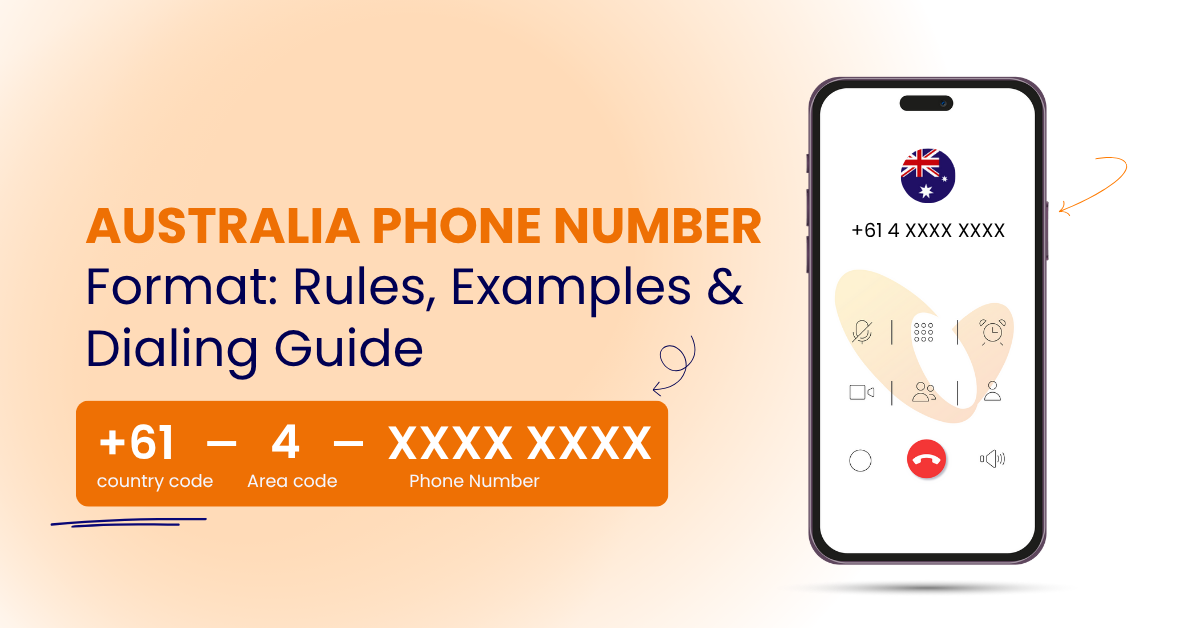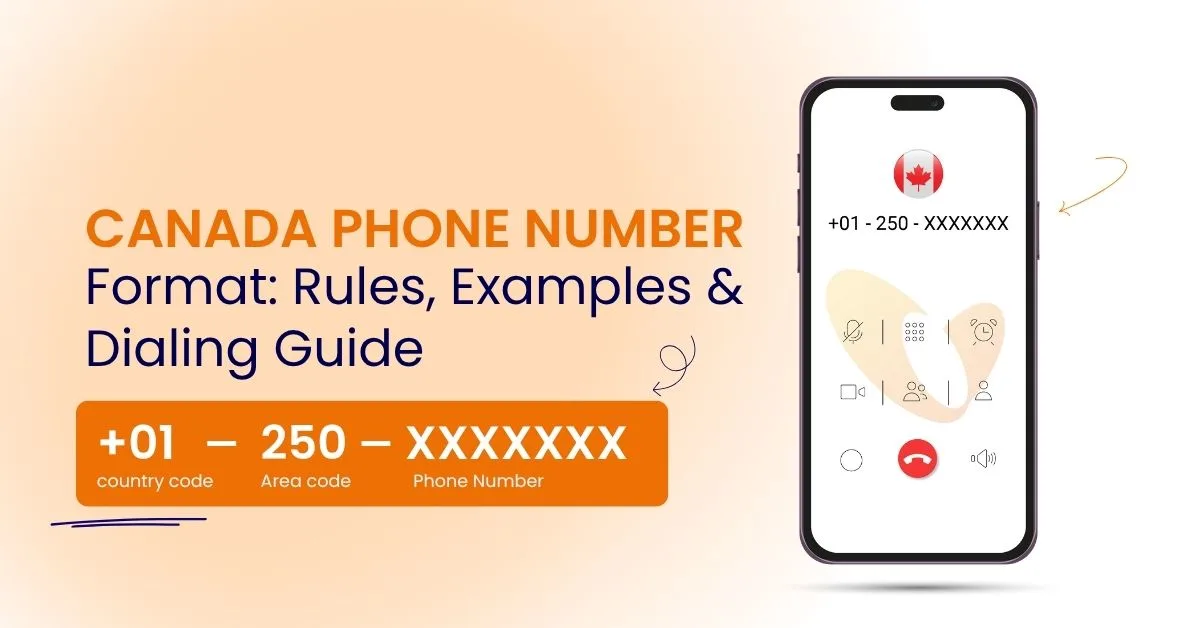Australia Phone Number Format Explained

6 min read
Table of Contents
Australia uses many types of phone numbers. These numbers appear in different ways across websites, forms, CRMs, and calling systems. When formats change, problems begin. A number written the wrong way can block calls, fail messages, or break automation inside business tools.
A single, clear Australia phone number format helps avoid these issues. It keeps communication simple and direct. It also allows systems like VoIP, CRM software, and cloud call tools to read numbers correctly. This guide explains every part of the Australian phone number format. It covers mobile numbers, landline numbers, virtual numbers, toll-free numbers, and special service numbers. It also explains how to dial an Australian number from other countries and how to store numbers safely and consistently.
Vitel Global helps companies use correct formats so calls reach the right people and systems stay clean.
Why the Australian Phone Number Format Matters for Business
Australian phone numbers change often when people share them online. Many users write numbers with brackets, dashes, or extra symbols. Others mix formats between local and international styles. These small changes can damage business processes and affect customer experience.
A phone number written incorrectly can break routing inside VoIP systems. It can also create duplicate records in CRMs. Marketing tools may reject numbers or fail to send messages. A simple format keeps everything stable. It also helps teams match customer records, track calls, and follow up with leads.
Using the same format also helps global callers reach Australian contacts without confusion. A clear and consistent number allows support teams, sales teams, and automated systems to handle communication without issues.
How to Dial Australia Phone Numbers
Australia uses a simple rule for dialing. The rule applies to both mobile phones and landline numbers. Every international call must begin with the country code +61. Local users inside Australia begin numbers with a leading zero. This zero must be removed in all global formats.
A simple formula helps:
- Use +61 for the country code.
- Remove the zero from the start of the local number.
- Add the area code or mobile indicator.
- Add the subscriber number with clear spacing.
Here is a correct example for a Sydney landline:
Domestic: (02) 8xxx xxxx
International: +61 2 8xxx xxxx
This structure helps both local and international users. It also works across CRMs, automated dialers, and cloud calling systems.
Australia Mobile Number Format Explained
Australian mobile numbers follow a very clear pattern. Every Australian mobile phone number starts with 04 in the national format. For international use, that number becomes +61 4. Australian mobile numbers always have ten digits when used inside the country.
Here is a simple example:
Local: 04xx xxx xxx
International: +61 4xx xxx xxx
The most common mistake is leaving the zero after +61. The number +61 04xx xxx xxx does not work. This error causes failed calls, blocked SMS messages, and rejected CRM entries. Removing the zero helps the number work on global networks.
Australian mobile numbers include a subscriber number that always fits the correct length. This allows VoIP systems, cloud calling platforms, and business communication tools to read numbers without trouble.
Australia Landline Number Format and Area Codes
Australian landline numbers use area codes that identify regions. These codes also help route calls within the country. Landline numbers always begin with a zero in Australia. When written internationally, this zero is replaced with +61.
Here are the most common area codes:
- 02 for New South Wales and ACT
- 03 for Victoria and Tasmania
- 07 for Queensland
- 08 for Western Australia, South Australia, and the Northern Territory
Landline numbers always contain eight digits after the area code. This simple structure makes numbers easy for systems to read.
Example for Melbourne:
Domestic: (03) 9xxx xxxx
International: +61 3 9xxx xxxx
This pattern works across all major cities, including Sydney, Melbourne, Brisbane, Perth, Adelaide, and Canberra.
Australia’s Telephone Numbering Plan Explained
The Australian telephone numbering plan defines how mobile numbers, landline numbers, toll-free numbers, and virtual numbers are structured. Each type of number has rules for length and format. These rules help networks handle calls safely and clearly.
The numbering plan includes:
- Mobile numbers that start with 04
- Landline numbers that use area codes
- Toll-free numbers that start with 1800 or 1300
- Short codes like 000 and 112
Subscriber numbers appear at the end of every mobile and landline number. These numbers form the base of the contact and remain the same across local and international formats.
The numbering plan keeps all numbers simple, readable, and easy to route.
How to Call Australia from Another Country
To call Australia from overseas, the caller must use a country exit code first. This exit code changes based on the caller’s country. After the exit code, the caller must dial +61. The caller must then type the rest of the number without the local zero.
Example:
Local: 0415 xxx xxx
International: +61 415 xxx xxx
The steps are simple and work for landline numbers, mobile phones, and virtual numbers.
Australia Contact Number Format for CRMs and VoIP Systems
Numbers must stay clean inside business systems. Extra symbols or brackets can break routing and ruin customer records. The international format is the best way to store Australian telephone numbers inside any system.
A clean number format includes:
- +61 at the start
- No slashes or brackets
- No leading zero
- Simple spacing
This format works for software tools, cloud systems, sales dashboards, and support platforms. It also helps companies avoid mistakes when importing customer lists or exporting data into new systems.
Non-Geographic Numbers in Australia
Australia uses several types of non-geographic numbers. These numbers are not tied to a region and help businesses reach customers across the country. They work well for service lines, national support teams, and marketing campaigns.
Common non-geographic formats include:
- 1300 xxx xxx
- 1800 xxx xxx
- 13 xx xx
These numbers may not work from other countries, but they remain essential for domestic communication. They allow companies to run national call centers and manage customer support lines without choosing a specific city.
Virtual Numbers in Australia
Australian virtual numbers give companies a local presence without needing a physical office in that region. These numbers follow the normal structure for landline or mobile numbers. They allow teams in other countries to receive calls from Australian customers.
A virtual number can display a Sydney, Melbourne, or Brisbane area code. The call can ring anywhere in the world. This helps companies grow in the Australian market while running support centers in other regions.
Virtual numbers help with:
- Customer trust
- Local presence
- Better call answer rates
- Simple routing across teams
Vitel Global supports virtual numbers across all major Australian cities.
Australia Phone Number Format Examples for Business Use
Here are simple examples of correct formats used inside business tools:
- Sydney: (02) 8xxx xxxx → +61 2 8xxx xxxx
- Melbourne: (03) 9xxx xxxx → +61 3 9xxx xxxx
- Brisbane: (07) xxxx xxxx → +61 7 xxxx xxxx
- Perth: (08) xxxx xxxx → +61 8 xxxx xxxx
- Mobile: 04xx xxx xxx → +61 4xx xxx xxx
These formats help CRMs, VoIP systems, and cloud tools store numbers correctly.
Special Service Numbers in Australia
Australia uses special numbers for emergency and public services. These numbers do not follow normal patterns. They must be kept separate inside business systems.
Emergency numbers include:
- 000 for urgent services
- 112 for mobile emergencies
- 106 for relay services
These numbers skip normal routing and must not be used in automated systems.
Why Exact Formatting Matters in VoIP Systems
VoIP systems need a clean number format to work well. Even a small error can break call routing. Brackets, hyphens, and extra zeros confuse dialers. Calls may fail or reach the wrong destination.
Correct formatting keeps calls clear and predictable. It also helps systems find the correct customer record, match call logs, and track performance.
Vitel Global normalizes numbers automatically to avoid errors in routing or CRM matching.
The Vitel Global Advantage for Australian Communication
Vitel Global helps businesses use clear and correct phone formats across all Australian regions. Companies gain virtual landline numbers, mobile numbers, and local presence across major cities. They also gain reliable cloud calling, CRM integration, and smart routing.
Vitel Global provides:
- Virtual Australian numbers
- AI-powered call tools
- Cloud VoIP solutions
- Accurate number formatting
- Fast porting and setup
These tools help companies communicate better with Australian clients and teams.
Australia Phone Numbers Made Simple for Your Business
Get clear and accurate Australia phone number formatting for smooth calling and easy routing across all your business systems.
Frequently Asked Questions
1. Does +61 replace the zero in Australian phone numbers?
Yes. +61 replaces the zero at the start of all Australian phone numbers. For example, 0412 xxx xxx becomes +61 412 xxx xxx. Removing the zero helps CRMs, VoIP systems, and global networks read the number correctly.
2. How do I format an Australian number for global calls?
Use +61 first. Remove the leading zero from the local version. Then add the area code or mobile code and the subscriber number. Keep the number clean. Avoid symbols. This simple format works with CRMs, VoIP tools, and global routing.
3. Do all Australian mobile numbers start with 04?
Yes. All Australian mobile numbers begin with 04 in local format. They appear as +61 4xx xxx xxx for global use. They must stay free of symbols and must follow this exact structure to work with business communication systems.
4. Is +61 the official country code for Australia?
Yes. +61 is the official country code for Australia. Some callers use 0061, but +61 is the global standard. Using +61 helps international callers, CRMs, and VoIP systems process the number without issues or routing errors.
5. What area codes do Australian landline numbers use?
Australian landlines use area codes such as 02 for New South Wales, 03 for Victoria, 07 for Queensland, and 08 for Western Australia. In global format, the zero is removed, and the number begins with +61 followed by the correct area digit.
6. What are non-geographic numbers in Australia?
Non-geographic numbers include 1300, 1800, and 13 numbers. They offer nationwide access without linking to a region. These numbers are used for support lines, sales lines, and national campaigns. They help businesses reach customers across the entire country.
7. How do I keep Australian contact numbers clean in CRMs?
Store numbers in the +61 format. Remove all symbols. Confirm that the number contains the correct length. Keep spacing simple. VoIP providers like Vitel Global help normalize numbers to reduce errors in routing, tracking, and customer matching.
8. What benefits does VoIP give for calls inside Australia?
VoIP improves call quality, reduces cost, supports virtual numbers, and adds smart routing. It also connects with CRM tools, tracks calls, and helps teams answer faster. VoIP makes communication easier across all Australian mobile numbers and landline numbers.
Published: November 19th, 2025
Tags:
- Australia contact number format
- Australia dialing guide
- Australia landline format
- Australia non-geographic numbers
- Australia phone number format
- Australian mobile number format
- Australian virtual numbers
- How to call Australia
- International phone number formatting
- Toll-free numbers Australia
- VoIP for Australia
Subscribe to Our Latest Updates
Get monthly product and feature updates, the latest industry news, and more!




